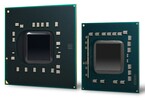Intel Graphics Media Accelerator (GMA) 600 vs Intel Graphics Media Accelerator (GMA) 4500MHD vs Intel Graphics Media Accelerator (GMA) 900
Intel Graphics Media Accelerator (GMA) 600
► remove from comparisonThe Intel Graphics Media Accelerator 600 (also called GMA 600) is a graphics cards for embedded products (e.g. MIDs), netbooks and other small mobile devices. It is integrated in the Atom Z600 series CPUs and compared to the GMA 500 it features a twice as high clock speed of max. 400 MHz. The integrated video decoder is able to accelerate MPEG-2, VC-1, and AVC HD videos.
The graphics core is based on a licensed PowerVR SGX core and is clocked with max 400 MHz. The GMA 600 should be theoretically compatible with DirectX 10.1 and features 4 unified shaders. Because of the missing Windows BIOS support, the Lincroft SOC is currently not able to run Windows (only CE) and therefore supports OpenGL ES 2.0, Open VG 1.0, DirectX 9.L. Another restriction is the max. resolution support of 1366x768 with LVDS and 1024x600 with MIPI.
The performance wont be sufficient for playing demanding 3D games.
Intel Graphics Media Accelerator (GMA) 4500MHD
► remove from comparison
The Intel Graphics Media Accelerator 4500MHD (sometimes also called GMA X4500 HD or other combinations) is a DirectX 10 capable onboard graphics adapter in the GM45, GE45 and GS45 chipset of the Centrino 2 platform (Montevina). The chip has no dedicated graphics memory, but takes dynamically an amount from the main memory (up to 384 MB). The graphics card is also called Mobile Intel(R) 4 Series Express Chipset Family in the Intel drivers.
The 400MHz clocked version of the 4500MHD found in the GL40 and GS40 chipsets, is called GMA 4500M (without the HD) and has a worse performance in 3D games and video decoding.
Compared to the predecessor GMA X3100, the GMA 4500MHD has two more shaders and a 33 MHz higher core clock speed. Therefore, the chip is noticable faster than the older one (especially in 3DMark06). Still, the performance is just on par with the entry level dedicated graphics cards and therefore not suited for demanding games. Some older games like Fear can be played in low details and low resolutions (see "Gaming Performance" below).
Compared to other modern integrated graphic cards like the Nvidia GeForce 9400M (G 102MNVIDIA GeForce G 105M) or AMD ATI Radeon HD 3200, the GMA 4500M HD noticably slower and provides less optimized drivers for games.
The version in the GS45 can be clocked lower (320 versus 533 MHz) and support only FSB 800 (instead of FSB 533/1066). Furthermore, switchable graphics are only supported in the GM45 chipset. The GE45 has the same features as the GM45, and aditionally is certified by Macrovision.
A new feature of the GMA chip, are the integrated HD video-decoding functions. The GM45 is able to decode HD-videos in the formats AVC, VC-2, and MPEG-2 to help the CPU. This way a Blu-Ray playback should also be possible with a low end CPU (only with the 533 MHz clocked version in the GM45 and GS45).

The graphics core in the GL40 and GS40 chipset with a lower core speed of 400 MHz is called GMA 4500M (without the HD). Because of the lower clock rate, the 4500M performs a bit worse in games and is not capable of decoding Blu-Ray videos fluently.
Intel Graphics Media Accelerator (GMA) 900
► remove from comparison
The Intel Graphics Media Accelerator 900 (also known as GMA 900) is an integrated (onboard) graphic chip on the Mobile Intel 915GM chipset for Intel processors. It does not support hardware T&L (Transform & Lightning) calculations (which is required for some games).
It supports DirectX 9.0 with Shader Model 2.0 (Vertex Shader are calculated in Software - by the CPU) and OpenGL 1.4. Furthermore, the chip is able to accelerate the decoding of MPEG2 videos and supports Motion Compensation.
The GMA 900 can not be described as a graphics card that is sufficient for gamers. Still Intel published a list of games that will run (not needingly beautiful) on the notebook. Some old 3D games and especially 2D games should run without problems. The advantage of integrated graphics cards, is that they have a low power consumtion and therefore save battery life. Furthermore, the laptop may stay cooler and more silent than laptops with dedicated graphics cards. For office programs and surfing the performance is more than sufficient.
Currently there are no drivers that support Aero Glass for Windows Vista.
| Intel Graphics Media Accelerator (GMA) 600 | Intel Graphics Media Accelerator (GMA) 4500MHD | Intel Graphics Media Accelerator (GMA) 900 | |||||||||||||||||||||||||||||||||||||||||||||||||||||||||||||||||||||||||
| GMA Series |
|
|
| ||||||||||||||||||||||||||||||||||||||||||||||||||||||||||||||||||||||||
| Codename | GMA 600 | Montevina | GMA 900 | ||||||||||||||||||||||||||||||||||||||||||||||||||||||||||||||||||||||||
| Architecture | PowerVR SGX5 | Gen. 4.5 | Gen. 3 | ||||||||||||||||||||||||||||||||||||||||||||||||||||||||||||||||||||||||
| Pipelines | 4 - unified | 10 - unified | 4 / 0 Pixel- / Vertexshader | ||||||||||||||||||||||||||||||||||||||||||||||||||||||||||||||||||||||||
| Core Speed | 400 MHz | 533 MHz | 400 MHz | ||||||||||||||||||||||||||||||||||||||||||||||||||||||||||||||||||||||||
| Shared Memory | yes | yes | no | ||||||||||||||||||||||||||||||||||||||||||||||||||||||||||||||||||||||||
| API | DirectX 9.0c, Shader 3.0 | DirectX 10, Shader 4.0 | DirectX 9c, Shader 2.0 | ||||||||||||||||||||||||||||||||||||||||||||||||||||||||||||||||||||||||
| technology | 45 nm | 65 nm | 130 nm | ||||||||||||||||||||||||||||||||||||||||||||||||||||||||||||||||||||||||
| Features | OpenGL, PowerVR SGX Kern, Screen Tiling, Internal True Color Processing, Zero overhead AA, 32 Bit floating-point operations. | Enhanced Intel Clear Video Technology, HD Video Decoder (VC/VC2/MPEG2), HDMI with HDCP support, Display Refresh Rate Switching Technology, Render Standby | No Hardware Transform and Lightning Support (T&L), MPEG2 acceleration, Motion Compensation | ||||||||||||||||||||||||||||||||||||||||||||||||||||||||||||||||||||||||
| Date of Announcement | 01.05.2010 | 01.10.2008 | 01.03.2005 | ||||||||||||||||||||||||||||||||||||||||||||||||||||||||||||||||||||||||
| Link to Manufacturer Page | www.intel.com | www.intel.com |
Benchmarks
Cinebench R15 OpenGL 64 Bit + Intel Graphics Media Accelerator (GMA) 4500MHD
Average Benchmarks Intel Graphics Media Accelerator (GMA) 600 → 100% n=4
Average Benchmarks Intel Graphics Media Accelerator (GMA) 4500MHD → 447% n=4
Average Benchmarks Intel Graphics Media Accelerator (GMA) 900 → 152% n=4
* Smaller numbers mean a higher performance
1 This benchmark is not used for the average calculation
Game Benchmarks
The following benchmarks stem from our benchmarks of review laptops. The performance depends on the used graphics memory, clock rate, processor, system settings, drivers, and operating systems. So the results don't have to be representative for all laptops with this GPU. For detailed information on the benchmark results, click on the fps number.

League of Legends
2019
Fifa 14
2013
Dead Space 3
2013
Dishonored
2012
World of Tanks v8
2012
Fifa 13
2012
Counter-Strike: GO
2012
Dirt Showdown
2012
Diablo III
2012
Mass Effect 3
2012
Fifa 12
2011
Dirt 3
2011
Crysis 2
2011
Fifa 11
2010
StarCraft 2
2010
CoD Modern Warfare 2
2009Average Gaming Intel Graphics Media Accelerator (GMA) 600 → 100%
Average Gaming Intel Graphics Media Accelerator (GMA) 4500MHD → -1634%
Average Gaming 30-70 fps → -2135%
Average Gaming Intel Graphics Media Accelerator (GMA) 900 → 134%
Average Gaming 30-70 fps → 134%
For more games that might be playable and a list of all games and graphics cards visit our Gaming List















































